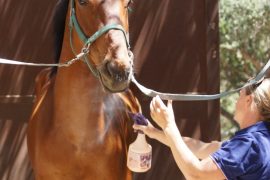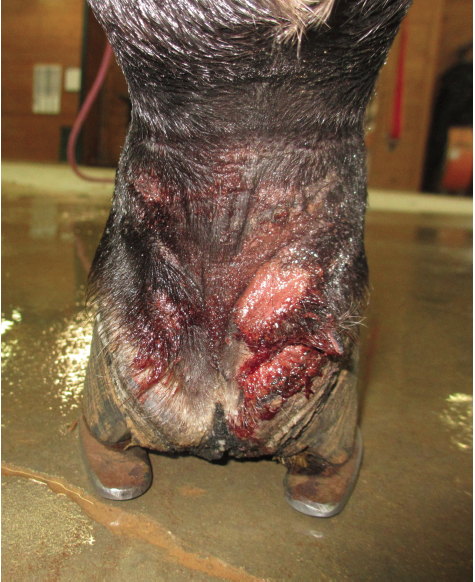Generally included in routine blood panels that may be recommended by your veterinarian, the blood chemistry profile gives insight into how your horse’s body is functioning metabolically as well as assessing how the major organs in the body are working. The blood chemistry profile, sometimes called a “chem panel”, will have results reported by the laboratory showing several different abbreviations. What are these abbreviations, and what do they tell us?
Na
Sodium. An electrolyte ion that plays a role in water regulation in the body. It helps maintain the level of plasma volume in the body. Low sodium may occur in instances of diarrhea or excessive sweating.
K
Potassium. An electrolyte ion that is important for nerve conduction, muscle contraction and regulation of the intracellular water balance. High potassium levels are extremely dangerous. Elevation in potassium levels may indicate kidney disease, muscle disease or metabolic damage. It may also indicate Addison’s disease or HYPP (hyperkalemic periodic paralysis). Low potassium levels may indicate a change in kidney function, loss from the gastrointestinal (GI) tract, or low dietary intake.
Cl
Chloride. An Ion that helps maintain electrolyte balance. Levels change as sodium changes. Low chloride may indicate an esophageal block. Chloride may be increased due to dehydration.
ALB
Albumin. A type of blood protein produced in the liver. Plays an important role in maintaining the ratio of water and solids in the blood. Levels may be decreased with chronic liver disease, kidney disease, inflammation, gastrointestinal malabsorption, malnutrition and with some viral diseases. May be increased with severe dehydration.
A/G ratio
Albumin:globulin ratio. Compares the ratio of albumin to globulin. Can be useful in determining if elevations are due to dehydration or disease process. If dehydrated, both levels will be elevated. When levels change independently of each other, it may indicate disease.
ALP
Alkaline phosphatase. An enzyme found in many types of tissue including liver, bone, kidney and intestinal tissue. Increased levels indicate liver disease or bile obstruction. Certain drugs may elevate ALP levels. Elevated levels may be found in young animals due to growing bone.
ALT (SGPT)
Alanine aminotransferase (serum glutamic pyruvic transaminase). An enzyme that may be increased due to liver, kidney or pancreatic damage.
Anion gap
Screens for acidosis (high acidity in the blood due to a metabolic imbalance). If this is elevated, acidosis is of concern.
AST (SGOT)
Asparatate aminotransferase (serum glutamic oxaloacetic transaminase). An enzyme found in many tissues, such as the heart, muscle, red blood cells, kidneys and liver. Muscle or liver damage may show as increased levels. Levels will be at their highest 24 hours after muscle injury.
BIL
Bilirubin. A pigment, orange in color, that is caused by the breakdown of hemoglobin in the liver. Causes the yellowing of tissues called “jaundice”. It is used as a measure of liver function. Elevated levels indicate liver disease, but can also be increased if the horse is not eating, or if a disease process is destroying red blood cells in the body.
BUN
Blood urea nitrogen. Measures the ability of the kidneys to remove waste nitrogen from the blood. Levels may be increased with kidney disease, dehydration or heart disease. Low levels may indicate liver disease, over hydration, or low dietary protein intake.
Calcium
An essential mineral that is important to the function of the skeleton, muscles, enzymes and blood. Elevated levels can indicate cancer, kidney failure or poor nutrition. Decreased levels may be seen during lactation.
CK
Creatine kinase. An enzyme produced by muscle cells. Levels increase with muscle damage.
Creatinine
Creatinine is a product of muscle breakdown that the kidneys are responsible for clearing from the blood. Elevated levels indicate kidney disease.
GGT
Gamma glutamyltranspeptidase. Increased levels of this enzyme indicate liver disease.
Globulin
A protein important to the immune system in helping to fight infection. An increase may be due to dehydration or increased antibody production. A decrease may indicate protein loss or immunodeficiency.
Glucose
A sugar that can be measured in the blood. Higher than normal levels can be associated with stress (pain, transportation, etc.), recent feeding, or metabolic disease such as Cushing’s disease. Low levels may be seen in instances of decreased food intake.
LDH
Lactate dehydrogenase. An enzyme that is released during tissue breakdown. Increases may occur with liver, muscle, or kidney damage.
Phosphorus
Closely tied to calcium levels. Phosphorus levels may increase if the kidneys are unable to excrete the excess phosphorus. It may also change if the calcium levels change, or with dietary changes.
TCO2
Total bicarbonate. Used to determine the acid-base balance in the body. A high tCO2 indicates a high pH, or metabolic alkalosis. A lower than normal tCO2 indicates a low pH, or metabolic acidosis.
Fibrinogen
A type of plasma protein that is released due to injury or inflammation in the body. Increased levels indicate acute injury or inflammation. Decreased levels may indicate an ongoing disease process. Levels may be higher than normal during pregnancy.
TP
Total protein or plasma protein. Measures the level of proteins in the blood. May be elevated with dehydration or chronic disease. Levels may be low with kidney disease, gastrointestinal disease, liver failure or malnutrition.
Navigating the medical alphabet that is included with your horse’s blood chemistry panel can be difficult, but with a little knowledge you may find it easier to understand what these abbreviations mean and how they may give you insight into your horse’s overall state of health. Your veterinarian is your best resource to determine what each of these results signify, so be sure to discuss the results with him or her to determine the best treatment plan for your horse.




